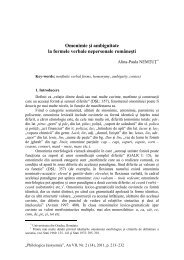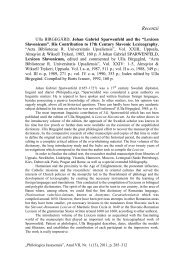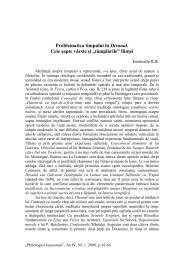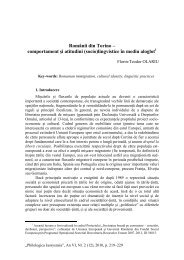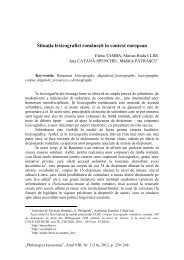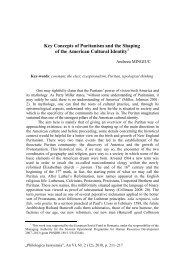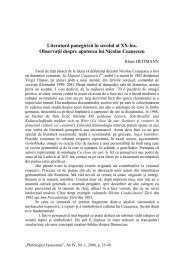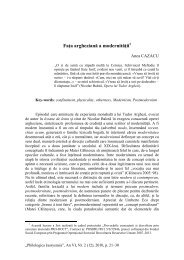O sutÄ de ani de cartografie lingvisticÄ româneascÄ - Philologica ...
O sutÄ de ani de cartografie lingvisticÄ româneascÄ - Philologica ...
O sutÄ de ani de cartografie lingvisticÄ româneascÄ - Philologica ...
Create successful ePaper yourself
Turn your PDF publications into a flip-book with our unique Google optimized e-Paper software.
Adrian PORUCIUC<br />
Rom<strong>ani</strong>an has in common with the Romance dialects of northern Italy and of the<br />
Alps, Densusianu continues as follows (1961: 157):<br />
There is, however, one aspect which makes the Rom<strong>ani</strong>an language get totally<br />
away from Italian and Rhetic and which remains to be clarified. As it has often been<br />
observed, there are no Old Germ<strong>ani</strong>c elements in Rom<strong>ani</strong>an, and it is due to that<br />
feature that Rom<strong>ani</strong>an has a singular position within the Romance family of<br />
languages 6 .<br />
Densusianu goes on (loc.cit.) by assuming that the early interruption of direct<br />
contacts between Italian and Rom<strong>ani</strong>an prevented OGEs that had been borrowed<br />
into Italian (mainly during the 5 th -6 th centuries) from reaching Rom<strong>ani</strong>an too (as if<br />
Rom<strong>ani</strong>an could get OGEs mainly via Italian!). As for the possible effects of direct<br />
(historically attested) contacts between Old Germ<strong>ani</strong>c populations and the natives<br />
of Southeast Europe, Densusianu consi<strong>de</strong>rs that Goths and Gepids simply „did not<br />
get into very close contact with the Roman population,” such a situation accounting<br />
for „the complete absence of Old Germ<strong>ani</strong>c elements in Rom<strong>ani</strong>an” (loc.cit.) 7 .<br />
After Densusianu’s time, whereas representatives of the Cluj school or<br />
philology, notably Puşcariu 8 and Giuglea, 9 pointed out cases of Rom<strong>ani</strong>an words<br />
that could be best explained as Old Germ<strong>ani</strong>sms, 10 important representatives of the<br />
schools of Bucharest (Rosetti) 11 and Iasi (Arvinte) 12 perpetuated an attitu<strong>de</strong> of<br />
extreme skepticism in regard to OGEs, such an attitu<strong>de</strong> actually being in keeping<br />
with a general one among European Rom<strong>ani</strong>sts. Here I do not refer to a certain neo-<br />
Roeslerian hard line (as represented by Schramm’s vision – see above), but rather to<br />
a peculiar reluctance to accept propositions of OGEs in Romance languages, as<br />
6 In the present article, all translations from Rom<strong>ani</strong>an and other languages into English are mine.<br />
7 The fact that Densusianu’s vision remained influential for quite a long time is visible in<br />
Ciorănescu’s rejection of previous propositions of Old Germ<strong>ani</strong>sms in Rom<strong>ani</strong>an (see, for instance the<br />
entries bor<strong>de</strong>i and fară in Ciorănescu’s the etymological dictionary, ed. 2001).<br />
8 I ma<strong>de</strong> use of Puşcariu’s Limba română, ed. 1976. Puşcariu takes into consi<strong>de</strong>ration (1976: 269)<br />
Old Germ<strong>ani</strong>c populations – Marcomanni, Goths, Gepids, Vandals and Langobards – that played<br />
significant military-political roles in Dacia “beginning with the second century of our time.” In a<br />
noteworthy statement, Puşcariu (loc.cit.) consi<strong>de</strong>rs that “it would not be surprising at all, if the direct<br />
contacts between our ancestors and Old Germ<strong>ani</strong>c populations should have left, in our language, traces<br />
like the ones recor<strong>de</strong>d in Dalmatia […]”.<br />
9 Giuglea is worth mentioning here mainly for his methodological statements that reflect his strong<br />
belief in the existence of OGEs in Rom<strong>ani</strong>an. In a special paper (first published in 1922, then<br />
republished in Giuglea1983: 91), Giuglea brings credible arguments in favor of the following i<strong>de</strong>a:<br />
“The earlier belief that an Old Germ<strong>ani</strong>c influence is to be exclu<strong>de</strong>d in the case of Rom<strong>ani</strong>an now<br />
appears to be a matter of wrong principle […]”.<br />
10 Significantly, although Meyer-Lübke, like many other outstanding Rom<strong>ani</strong>sts, appears to be<br />
quite cautious about the very i<strong>de</strong>a of OEGs in Rom<strong>ani</strong>an, in his REW he inclu<strong>de</strong>s (without any<br />
criticism) several of the Old Germ<strong>ani</strong>sms propoun<strong>de</strong>d by Puşcariu (rum. râncaciu ‘halbkastriert’ – s.v.<br />
7044. rank; rum. rapăn ‘Räu<strong>de</strong>’, rapură ‘eine Fußkrankheit’ – s.v. 7059. rappe ‘Grind’) and by<br />
Giuglea (rum. strungă ‘Melkhür<strong>de</strong>’ – s.v. stanga ‘Stange’; rum. stinghe ‘dünne Stange’ – s.v. *stingils<br />
‘Stengel’; rum. tapă ‘Spund’ – s.v. tappa ‘Spund’, ‘Zapfen’). In regard to Meyer-Lübke’s vision of<br />
OEGs, see also Poruciuc 2009b.<br />
11 See especially the minute presentation of quite many opinions (on the issue of OGRs in<br />
Rom<strong>ani</strong>an) in the chapter “Germ<strong>ani</strong>ca” inclu<strong>de</strong>d in Rosetti’s Istoria limbii române (1986: 220−224).<br />
12 Arvinte’s many doubts about the issue of OGRs in Rom<strong>ani</strong>an are m<strong>ani</strong>fest in his volume of 2002<br />
(see especially pages 9−10).<br />
182



